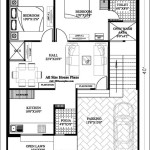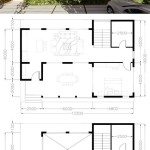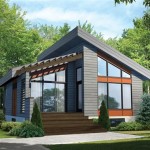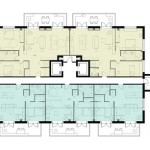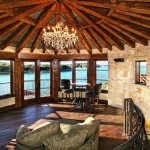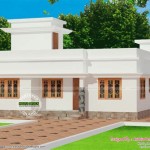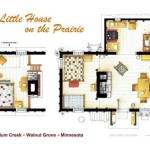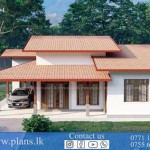Modern House Plans For Narrow Lots With Front Garage
The increasing scarcity of land, particularly in urban and suburban areas, has led to a surge in demand for efficient and innovative housing solutions. Modern house plans designed specifically for narrow lots with front garages represent a significant response to this challenge. These plans prioritize maximizing space utilization, incorporating contemporary design aesthetics, and providing the essential convenience of a garage, all while adhering to the spatial constraints imposed by narrow lot dimensions.
Developing a successful house plan for a narrow lot with a front garage requires careful consideration of several key factors. Zoning regulations and setback requirements often dictate the allowable building footprint, influencing the overall design. Optimal orientation on the lot is crucial for maximizing natural light and energy efficiency. Interior layout must prioritize functionality and spatial efficiency to create a comfortable and livable environment, despite the limited width. Finally, aesthetic considerations play a vital role in ensuring the house possesses curb appeal and integrates harmoniously with the surrounding neighborhood.
This article explores the key considerations and design principles associated with modern house plans for narrow lots with front garages, highlighting the strategies employed to overcome spatial limitations and achieve a balance between functionality, aesthetics, and cost-effectiveness.
Optimizing Space and Layout in Narrow Lot Homes
The primary challenge in designing for narrow lots is maximizing usable space while adhering to building codes and maintaining a comfortable living environment. Several architectural and design strategies are commonly employed to address this challenge. These strategies focus on minimizing wasted space, optimizing flow, and creating an illusion of spaciousness.
One effective technique is the utilization of open floor plans. By eliminating or minimizing the number of interior walls, particularly on the main living level, a greater sense of openness and connectivity can be achieved. This allows natural light to penetrate deeper into the house, further contributing to the perception of spaciousness. Strategic placement of furniture and the incorporation of defined zones within the open space can help to delineate different functions without the need for physical barriers. Features such as kitchen islands or peninsulas can serve as both functional workspaces and visual dividers.
Vertical expansion is another common approach used in narrow lot homes. Building upwards, by incorporating multiple stories, allows for a significant increase in living space without expanding the footprint of the house. This is particularly useful when the allowable building footprint is limited by zoning regulations or lot size. Careful consideration must be given to the placement of stairs to minimize their impact on the overall floor plan and to ensure they are integrated seamlessly into the design.
Strategic use of natural light is crucial in creating a bright and airy interior. Large windows, skylights, and strategically placed doors can maximize the amount of natural light entering the house. The orientation of the house on the lot should be carefully considered to take advantage of sunlight throughout the day. Light-colored interior finishes and reflective surfaces can further enhance the effect of natural light and contribute to a feeling of spaciousness. Minimizing the use of heavy drapes or curtains can also help to maximize natural light penetration.
Built-in storage solutions and multi-functional furniture are essential for maximizing space utilization in narrow lot homes. Built-in shelves, cabinets, and closets can provide ample storage without taking up valuable floor space. Multi-functional furniture, such as sofa beds or tables with storage compartments, can further enhance space efficiency. Carefully planning the placement of furniture to ensure it does not obstruct walkways or create unnecessary clutter is also crucial.
The location of the garage at the front of the lot presents a unique challenge. It often necessitates locating the main entry door on the side of the house, requiring a thoughtful design for the entry sequence. This often involves a covered porch or walkway to provide shelter and create a welcoming entrance. The design should also consider the visual impact of the garage door on the overall aesthetic of the house.
Aesthetic Considerations and Curb Appeal for Narrow Lot Homes
While functionality and space efficiency are paramount in designing narrow lot homes, aesthetic considerations are equally important. The exterior design should be visually appealing and integrate harmoniously with the surrounding neighborhood. Careful attention to architectural style, materials, and landscaping can significantly enhance the curb appeal of the house.
Modern architectural styles are often well-suited for narrow lot homes due to their emphasis on clean lines, simple forms, and efficient use of space. Styles such as contemporary, minimalist, and mid-century modern often feature sleek facades, large windows, and open floor plans, all of which can contribute to a sense of spaciousness and visual appeal. The choice of exterior materials should be carefully considered to create a cohesive and aesthetically pleasing design. Materials such as brick, stone, wood siding, and metal cladding can be combined in various ways to create a unique and visually interesting façade.
The placement and design of windows play a crucial role in both the aesthetic and functional aspects of the house. Large windows can maximize natural light and provide views of the surrounding landscape, while smaller windows can provide privacy and ventilation. The arrangement of windows should be carefully considered to create a balanced and visually appealing façade. Window trim and mullions can also add architectural detail and enhance the overall design.
Landscaping can significantly enhance the curb appeal of a narrow lot home. A well-designed landscape can soften the appearance of the house, provide privacy, and create a welcoming entrance. The choice of plants should be carefully considered to ensure they are appropriate for the climate and require minimal maintenance. Low-maintenance landscaping options, such as drought-tolerant plants and native species, are often ideal for narrow lot homes. The use of hardscaping elements, such as walkways, patios, and retaining walls, can also enhance the overall aesthetic of the landscape.
The garage door can have a significant impact on the curb appeal of a narrow lot home. Choosing a garage door that complements the architectural style of the house and incorporates design elements such as windows or decorative hardware can enhance the overall aesthetic. The color of the garage door should also be carefully considered to ensure it blends seamlessly with the façade of the house.
Exterior lighting plays a crucial role in enhancing the curb appeal of a narrow lot home, particularly at night. Strategically placed lighting can highlight architectural features, illuminate walkways, and create a welcoming atmosphere. Energy-efficient LED lighting options are a practical and environmentally friendly choice. Motion-sensor lighting can also provide added security and convenience.
Addressing Functional Considerations and Building Codes
In addition to space optimization and aesthetic appeal, designing narrow lot homes with front garages requires careful consideration of functional requirements and adherence to building codes. These aspects are essential for ensuring the safety, comfort, and long-term viability of the house.
Building codes often dictate specific requirements for setbacks, lot coverage, and building height. Setbacks are the minimum distances that a building must be set back from property lines. Lot coverage refers to the percentage of the lot that can be covered by buildings. Building height is the maximum allowable height of the house. These regulations can significantly impact the design of a narrow lot home and must be carefully considered from the outset of the design process.
Fire safety is a critical consideration in all residential construction, but it is particularly important in narrow lot homes where houses are often located close together. Building codes typically require specific fire-resistant construction materials and fire separation between adjacent buildings. Sprinkler systems may also be required in some jurisdictions. Smoke detectors and carbon monoxide detectors are essential safety features in all homes.
Accessibility considerations are becoming increasingly important in residential design. Designing a narrow lot home with accessibility in mind can enhance its usability for people of all ages and abilities. Features such as ramps, wider doorways, and grab bars can make the house more accessible for people with mobility limitations. Universal design principles, which aim to create buildings that are usable by everyone to the greatest extent possible, can be incorporated into the design to create a more inclusive and accessible living environment.
Energy efficiency is another crucial consideration in modern house design. Incorporating energy-efficient features such as high-performance windows, insulation, and HVAC systems can significantly reduce energy consumption and lower utility bills. Solar panels can also be integrated into the design to generate renewable energy. Orienting the house on the lot to maximize solar gain in the winter and minimize solar gain in the summer can also contribute to energy efficiency.
Proper drainage and stormwater management are essential for preventing water damage and maintaining the structural integrity of the house. Designing the property to effectively manage stormwater runoff is crucial, especially in areas with heavy rainfall. This can involve incorporating features such as rain gardens, permeable paving, and drainage swales.
The placement of utilities, such as water, sewer, and electrical lines, must be carefully considered during the design process. Coordinating with utility companies to ensure that the necessary services are available and properly connected is essential. The location of utility meters and access points should be carefully planned to minimize their visual impact on the house.
Designing modern house plans for narrow lots with front garages presents a unique set of challenges and opportunities. By carefully considering the key factors outlined in this article, it is possible to create functional, aesthetically pleasing, and energy-efficient homes that maximize space utilization and enhance the quality of life for their occupants.

20 Luxury Narrow House Plans With Front Garage

Contemporary Two Story House Plan 1974

House Plan 3 Bedrooms 2 5 Bathrooms Garage 3877 V1 Drummond Plans

Modern Narrow House Plan View Park Beach Plans Designs

Modern Narrow Lot House Plans And Architectural Designs Houseplans Blog Com

Narrow Lot House Plans Home For Lots The Designers

Small Modern Farmhouse House Plans Narrow Lot Designs

Narrow Lot House Plans And Designs Sater Design Collection

Narrow Lot Traditional Neighborhood Development Plans

Modern Narrow Lot House Plans And Architectural Designs Houseplans Blog Com

